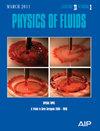Machine learning and numerical simulation research on specific energy consumption for gradated coarse particle two-phase flow in inclined pipes
IF 4.1
2区 工程技术
Q1 MECHANICS
引用次数: 0
Abstract
In deep-sea mining engineering, accurately predicting the energy required per unit length of pipeline to transport a unit mass of solids (dimensionless specific energy consumption, DSEC) is crucial for ensuring energy conservation and efficiency in the project. Based on our previous work, we utilized the machine learning (ML) and the computational fluid dynamics (CFD)–discrete element method (DEM) method to study the transport characteristics and flow field variations of gradated coarse particles in inclined pipes (gradated particles refer to solid particles mixed in specific size and quantity ratios). First, we collect 1185 sets of data from 13 experimental literature, and after analyzing and processing them, an ensemble model based on four other ML models is developed. Both for pure substance particles (PS) and mixed particles (MP), the prediction accuracy of this ensemble model is relatively higher (PSs are spherical particles with uniform size and density, and MPs are particles with different shapes, sizes, and densities). Then, the CFD-DEM process and the operating conditions include low flow velocity with low volume concentration (2 m/s and 2.5%), low flow velocity with high volume concentration (2 m/s and 7.5%), and high flow velocity with low volume concentration (4 m/s and 2.5%). Under conditions of low flow velocity and low concentrations, as well as high flow velocity and low concentrations, the DSEC hardly changes with the variation of the pipe inclination angle. Under low flow velocity and high-concentration conditions, as the pipe gradually becomes vertical, the value of DSEC gradually increases.倾斜管道中分级粗颗粒两相流比能耗的机器学习与数值模拟研究
在深海采矿工程中,准确预测单位长度管道输送单位质量固体所需的能量(无量纲比能耗,DSEC)对于确保工程的节能和效率至关重要。在前期工作的基础上,我们利用机器学习(ML)和计算流体动力学(CFD)-离散元法(DEM)方法,研究了倾斜管道中分级粗颗粒(分级颗粒指以特定尺寸和数量比混合的固体颗粒)的输送特性和流场变化。首先,我们从 13 篇实验文献中收集了 1185 组数据,经过分析处理后,建立了基于其他四个 ML 模型的集合模型。无论是对于纯物质颗粒(PS)还是混合颗粒(MP),该集合模型的预测精度都相对较高(PS 为大小和密度均匀的球形颗粒,MP 为形状、大小和密度不同的颗粒)。然后,CFD-DEM 过程和运行条件包括低流速低体积浓度(2 m/s 和 2.5%)、低流速高体积浓度(2 m/s 和 7.5%)以及高流速低体积浓度(4 m/s 和 2.5%)。在低流速、低浓度和高流速、低浓度条件下,DSEC 几乎不随管道倾角的变化而变化。在低流速和高浓度条件下,随着管道逐渐垂直,DSEC 值逐渐增大。
本文章由计算机程序翻译,如有差异,请以英文原文为准。
求助全文
约1分钟内获得全文
求助全文
来源期刊

Physics of Fluids
物理-力学
CiteScore
6.50
自引率
41.30%
发文量
2063
审稿时长
2.6 months
期刊介绍:
Physics of Fluids (PoF) is a preeminent journal devoted to publishing original theoretical, computational, and experimental contributions to the understanding of the dynamics of gases, liquids, and complex or multiphase fluids. Topics published in PoF are diverse and reflect the most important subjects in fluid dynamics, including, but not limited to:
-Acoustics
-Aerospace and aeronautical flow
-Astrophysical flow
-Biofluid mechanics
-Cavitation and cavitating flows
-Combustion flows
-Complex fluids
-Compressible flow
-Computational fluid dynamics
-Contact lines
-Continuum mechanics
-Convection
-Cryogenic flow
-Droplets
-Electrical and magnetic effects in fluid flow
-Foam, bubble, and film mechanics
-Flow control
-Flow instability and transition
-Flow orientation and anisotropy
-Flows with other transport phenomena
-Flows with complex boundary conditions
-Flow visualization
-Fluid mechanics
-Fluid physical properties
-Fluid–structure interactions
-Free surface flows
-Geophysical flow
-Interfacial flow
-Knudsen flow
-Laminar flow
-Liquid crystals
-Mathematics of fluids
-Micro- and nanofluid mechanics
-Mixing
-Molecular theory
-Nanofluidics
-Particulate, multiphase, and granular flow
-Processing flows
-Relativistic fluid mechanics
-Rotating flows
-Shock wave phenomena
-Soft matter
-Stratified flows
-Supercritical fluids
-Superfluidity
-Thermodynamics of flow systems
-Transonic flow
-Turbulent flow
-Viscous and non-Newtonian flow
-Viscoelasticity
-Vortex dynamics
-Waves
文献相关原料
| 公司名称 | 产品信息 | 采购帮参考价格 |
|---|
 求助内容:
求助内容: 应助结果提醒方式:
应助结果提醒方式:


